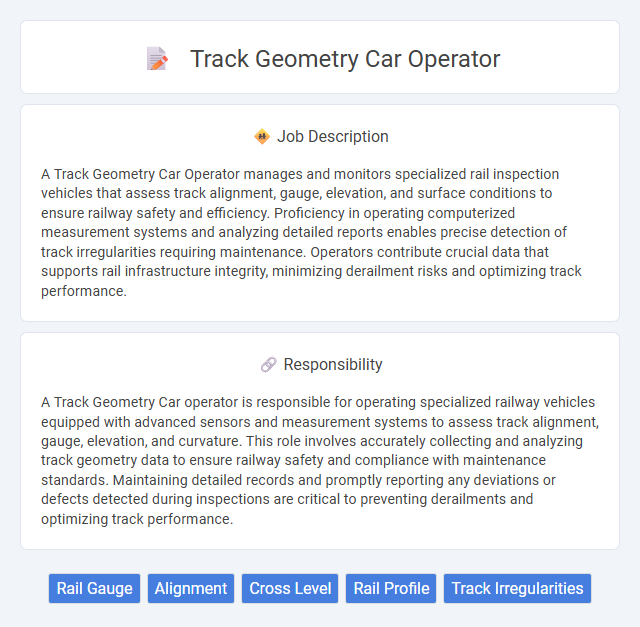
A Track Geometry Car Operator manages and monitors specialized rail inspection vehicles that assess track alignment, gauge, elevation, and surface conditions to ensure railway safety and efficiency. Proficiency in operating computerized measurement systems and analyzing detailed reports enables precise detection of track irregularities requiring maintenance. Operators contribute crucial data that supports rail infrastructure integrity, minimizing derailment risks and optimizing track performance.
Individuals with strong attention to detail and physical stamina are likely suitable for a track geometry car operator role, as the job involves inspecting railroad tracks for safety and alignment. Candidates with good spatial awareness and mechanical aptitude may have a higher probability of performing well in this position. Those with health issues affecting mobility or vision might find it challenging to meet the job's physical and observational demands.
Qualification
Track geometry car operators must possess a strong background in railway maintenance and track inspection, often requiring certification in track safety and railroad operations. Proficiency in operating specialized track geometry measurement equipment, understanding track alignment, and interpreting technical data is essential. Candidates typically need a high school diploma or equivalent, with specialized training or experience in railroad track engineering preferred.
Responsibility
A Track Geometry Car operator is responsible for operating specialized railway vehicles equipped with advanced sensors and measurement systems to assess track alignment, gauge, elevation, and curvature. This role involves accurately collecting and analyzing track geometry data to ensure railway safety and compliance with maintenance standards. Maintaining detailed records and promptly reporting any deviations or defects detected during inspections are critical to preventing derailments and optimizing track performance.
Benefit
Operating a track geometry car likely offers substantial benefits such as competitive salary and opportunities for overtime pay due to the critical nature of maintaining rail safety. Employees may enjoy access to specialized training programs, enhancing their skill set and career prospects within the rail industry. Health insurance, retirement plans, and potential travel perks could also be probable advantages associated with this role.
Challenge
Operating a track geometry car likely demands high precision and constant vigilance due to the complexity of monitoring railroad track conditions. The role may involve managing advanced technology under varying weather and terrain conditions, increasing operational difficulty. Challenges could arise from interpreting real-time data accurately to prevent potential track failures, making this job both critical and demanding.
Career Advancement
Track geometry car operators play a critical role in maintaining railway safety by measuring and analyzing track alignment, elevation, and gauge using specialized inspection vehicles. Career advancement opportunities include transitioning to roles such as track supervisor, railway engineer, or maintenance manager, often requiring additional certifications and technical training. Mastery of advanced diagnostic tools and data analytics enhances promotion prospects within the rail infrastructure sector.
Key Terms
Rail Gauge
Track geometry car operators specialize in measuring and analyzing rail gauge to ensure safe and efficient train travel. Precise monitoring of rail gauge, the distance between two rails, is critical to prevent derailments and maintain track integrity. Using advanced track geometry cars equipped with sensors and lasers, operators collect data to detect gauge deviations and inform maintenance schedules.
Alignment
Track geometry car operators specialize in monitoring and adjusting railroad track alignment to ensure optimal safety and performance. They utilize advanced measurement instruments and software to detect deviations in track position and correct misalignments such as gauge, cant, and twist. Precise alignment maintenance by these operators reduces the risk of derailments and maximizes train efficiency throughout the rail network.
Cross Level
A Track Geometry Car Operator monitors and measures the cross level of railway tracks to ensure safety and stability. This role involves operating specialized track geometry cars equipped with precision sensors to detect deviations in cross level, which directly impact train ride quality and track integrity. Accurate cross level data collection supports timely maintenance decisions, preventing track-related accidents and enhancing overall rail infrastructure reliability.
Rail Profile
A Track Geometry Car operator specializes in monitoring and evaluating the rail profile to ensure optimal track alignment and safety. Utilizing advanced sensors and laser measurement technologies, the operator collects precise data on rail wear, corrugation, and gauge deviations. Accurate analysis of rail profile helps prevent track failures, reduces maintenance costs, and enhances the durability of the railway infrastructure.
Track Irregularities
Track geometry car operators analyze and manage track irregularities by using specialized cars equipped with advanced sensors and measuring instruments to detect misalignments, gauge variations, and surface defects. Precise identification of irregularities such as twists, dips, and cross-level deviations ensures maintenance teams can implement timely repairs, enhancing rail safety and ride quality. Operators must interpret data accurately to maintain compliance with Federal Railroad Administration (FRA) standards and prevent potential derailments.
 kuljobs.com
kuljobs.com